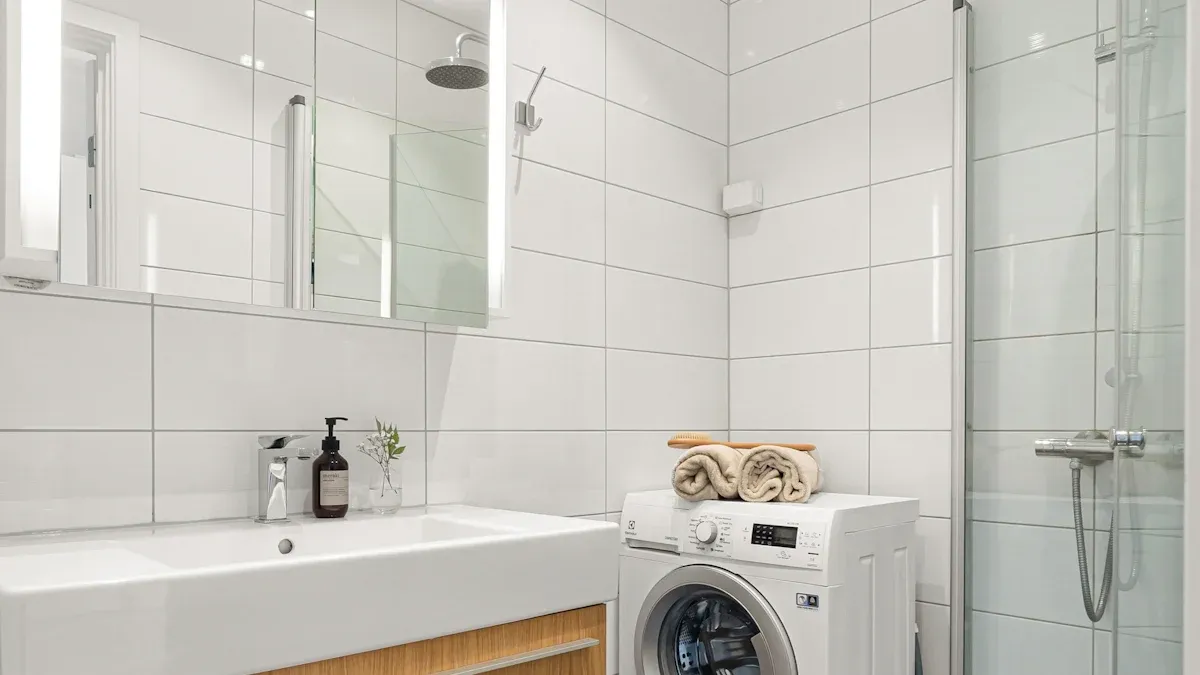
You can replace the heating element in your Whirlpool dryer with the right tools and careful attention to safety. Whirlpool designs its appliances for user-friendly repairs, so you do not need advanced skills to restore your dryer’s performance. Always disconnect your Whirlpool dryer from power before you start. This approach helps prevent injuries and ensures you achieve reliable results when you replace heating element parts.
Signs You Need to Replace Heating Element in Your Whirlpool Dryer
Common Whirlpool Dryer Heating Element Failure Symptoms
A malfunctioning whirlpool dryer often shows clear signs that point to a faulty heating element. You can spot these symptoms early and prevent further damage to your appliance.
Dryer not heating
You may notice your whirlpool dryer runs but fails to produce heat. This is the most common symptom of a faulty heating element. When the heating element breaks internally, it creates an open circuit. As a result, your clothes remain damp after a full cycle. According to appliance repair data, the heating element causes 38% of no-heat issues in whirlpool dryers, making it the leading culprit.
Clothes take too long to dry
If your whirlpool dryer takes much longer than usual to dry clothes, you should suspect a problem with the heating element. A partially failed heating element or a multi-coil element with one broken coil can reduce heating efficiency. This leads to extended drying times and increased energy use.
Dryer shuts off mid-cycle
A whirlpool dryer that shuts off before completing a cycle may have an overheating issue. Overheating often results from a faulty heating element or blocked ventilation. Overloaded dryers and poor maintenance can also cause the heating element to fail prematurely.
Visible damage to the heating element
Sometimes, you can see physical damage to the heating element. Look for broken or burned-out coils inside the heating element housing. However, not all failures show visible signs. You may need to test the heating element to confirm the issue.
Mẹo: Regular maintenance helps prevent many common causes of heating element failure, such as clogged vents and overloaded dryers.
How to Confirm a Faulty Whirlpool Dryer Heating Element
You should confirm a faulty heating element before replacing it. Appliance experts recommend two main diagnostic methods.
Visual inspection of the heating element
Start by unplugging your whirlpool dryer and removing the rear panel. Inspect the heating element for visible breaks, burns, or other damage. If you see a broken coil or a burned spot, you have found a faulty heating element. However, some failures are not visible, so you need to use a multimeter for a more accurate diagnosis.
Using a multimeter to test for continuity
To test the heating element, follow these steps:
- Disconnect the wires from the whirlpool dryer heating element.
- Set your multimeter to the continuity or ohms setting.
- Place the probes on the heating element terminals.
- If the multimeter shows continuity, the element is intact. If not, you have a faulty heating element.
- Test between each terminal and the metal case. You should not find continuity here. If you do, the element is grounded and must be replaced.
- If the heating element passes these tests but your whirlpool dryer still does not heat, check related parts such as the thermal fuse, thermostat, and control board.
Ghi chú: Always use quality replacement parts for your whirlpool dryer heating element to avoid repeated failures.
You can prevent most heating element failures by maintaining your whirlpool dryer. Avoid overloading, clean the lint trap and vent regularly, and address any unusual noises or performance issues promptly. These steps help extend the life of your whirlpool dryer and keep it running efficiently.
Tools and Parts Needed to Replace Whirlpool Dryer Heating Element
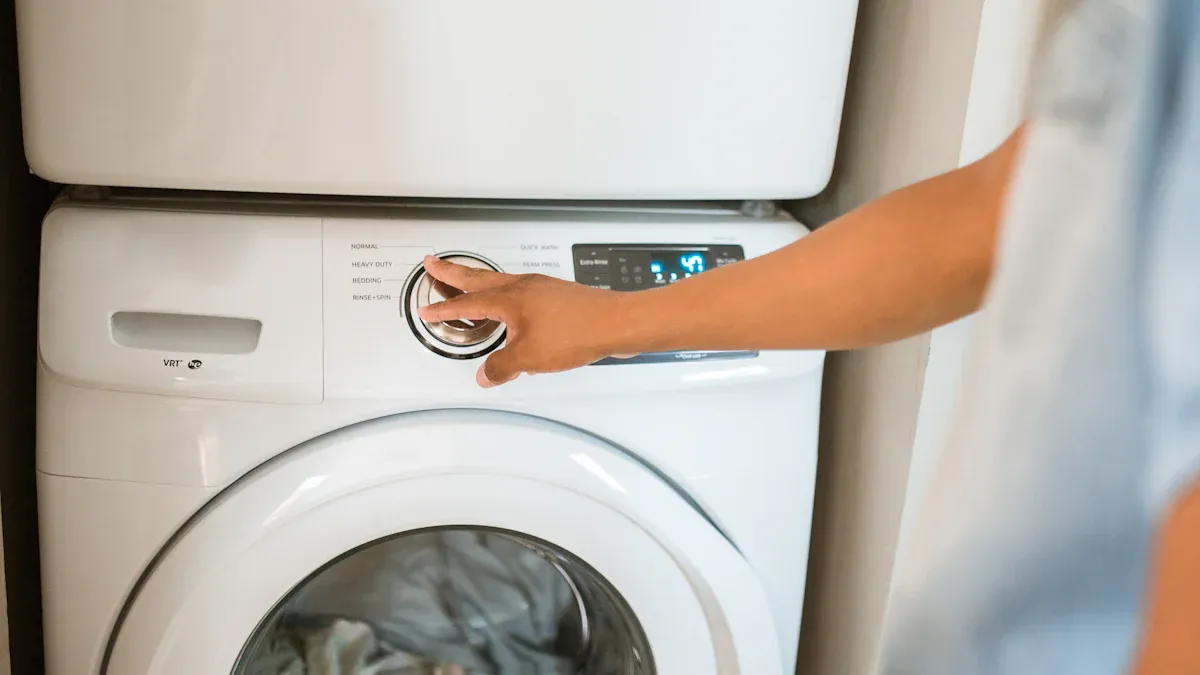
Before you begin replacing your whirlpool dryer heating element, you need to gather the right tools and replacement parts. Using the correct equipment ensures a smooth, safe, and efficient repair process. You also reduce the risk of damaging your whirlpool dryer or its components.
Essential Tools for Dryer Repair
You should prepare a set of basic tools before starting your whirlpool dryer repair. These tools help you access, remove, and install the heating element without causing harm to the appliance.
Phillips and flathead screwdrivers
You will use both Phillips and flathead screwdrivers to remove and reattach panels on your whirlpool dryer. These screwdrivers fit most screws found on the exterior and interior of the appliance.
1/4″ nut driver or socket set
A 1/4″ nut driver or socket set allows you to remove nuts and bolts that secure the heating element housing. Whirlpool dryers often use these fasteners for mounting internal components.
Đồng hồ vạn năng
A multimeter is essential for testing the whirlpool dryer heating element and related parts. You can check for continuity in the heating element, thermal fuse, and thermostat. This step helps you confirm which part needs replacement.
Găng tay làm việc
Work gloves protect your hands from sharp edges and hot surfaces inside the whirlpool dryer. Always wear gloves to prevent injuries during the repair.
Mẹo: Organize your tools before you start. Place them within easy reach to avoid unnecessary delays during the repair.
Replacement Parts for Whirlpool Dryer
Selecting the right replacement parts is crucial for restoring your whirlpool dryer’s performance. Always choose OEM (Original Equipment Manufacturer) parts for the best fit and durability.
Compatible Whirlpool dryer heating element (e.g., part 279838)
The most common whirlpool dryer heating element is part 279838. This heating element fits many popular whirlpool dryer models, including Wed4815ew1, Medc215ew1, and Ler4634eq0. You can also find compatible alternatives such as W10724237, 8565582, and 279838VP. These heating elements feature high-quality nickel material for durability and easy installation. Many kits include a thermal fuse, thermistor, and thermostat for a complete repair.

You can purchase genuine whirlpool dryer heating element parts from official sources like WhirlpoolParts.com. This distributor offers a wide selection of OEM parts, next-day shipping, and a 365-day return policy. You will also find instructional videos and customer support to guide you through the process.
| Replacement Part | Description and Notes |
|---|---|
| Heating Element Assembly | Primary component replaced when dryer does not heat properly; often has a break in the coil if defective. |
| Radiant Surface Element | Part of the heating system, sometimes replaced alongside the heating element. |
| Thermostat Heater | Controls temperature; recommended to check and replace if faulty. |
| Cầu chì nhiệt | Common cause of heating failure; should be checked before replacing the heating element. |
| Thermal Cut Out | Safety device that may need replacement if heating issues persist. |
| Wiring Terminals | May require replacement if damaged during servicing. |
Optional: new thermal fuse or thermostat
You may need to replace the thermal fuse or thermostat if your whirlpool dryer continues to have heating issues. These components often fail alongside the heating element. Testing them with a multimeter helps you identify faulty parts. Many repair kits include these items for your convenience.
Ghi chú: Always unplug your whirlpool dryer before servicing. Carefully disconnect wires and note their positions to ensure proper reassembly.
By preparing the right tools and parts, you set yourself up for a successful whirlpool dryer heating element replacement. This approach saves time and helps you restore your whirlpool dryer to optimal performance.
Safety Steps Before You Remove the Heating Element from Your Dryer
Before you begin any repair on your Whirlpool dryer, you must take important safety steps. These precautions protect you from electrical shock, gas leaks, and accidental injury. Following best practices ensures a smooth and safe repair process.
Disconnecting Power and Preparing the Whirlpool Dryer
Unplugging the dryer and ensuring no electrical connection
You must always disconnect your dryer from the power source before starting any repair. This step prevents electrical hazards and keeps you safe during the process. Follow these steps to ensure your dryer is completely isolated from electricity:
- Unplug the dryer from the electrical outlet.
- Disconnect the grounding wire to further reduce the risk of electric shock.
- Wear protective gear, such as gloves and safety goggles, to protect your hands and eyes from injury.
Mẹo: Never attempt to test or handle live wiring. Use insulated gloves and non-conductive tools when working near electrical components.
Gas dryer precautions if applicable
If you have a gas dryer, you need to take extra precautions to prevent gas leaks or accidents. Always turn off the gas supply before moving or repairing your appliance. Here are the recommended steps:
- Turn off the gas supply valve on the supply pipe.
- Make sure the gas is completely shut off before disconnecting the gas line or moving the dryer.
- Always turn off the gas supply before performing any electrical work.
Ghi chú: Consult your user manual for specific instructions related to your gas dryer model.
Setting Up a Safe Workspace for Dryer Repair
Clearing the area around the dryer
A clean and organized workspace helps you avoid accidents and makes the repair process more efficient. Take the following steps to prepare your area:
- Clear the area around the dryer of any clutter, tools, or laundry.
- Keep children and pets away from the workspace.
- Ensure the area is well-lit so you can see all components clearly.
- Allow the dryer to cool down if it was recently in use.
Organizing tools and replacement parts
Proper organization of your tools and replacement parts streamlines the repair and reduces the risk of losing small components. Use these best practices:
- Lay out all necessary tools, such as screwdrivers, nut drivers, and a multimeter, within easy reach.
- Place replacement parts, like the heating element and thermal fuse, on a clean surface.
- Wear insulated gloves to protect your hands from sharp edges and electrical hazards.
- Handle all parts gently to avoid damage.
Safety Reminder: Always consult your dryer’s user manual for any model-specific safety or installation instructions.
By following these safety steps, you minimize risks and set yourself up for a successful Whirlpool dryer heating element replacement.
How to Remove the Heating Element from a Whirlpool Dryer
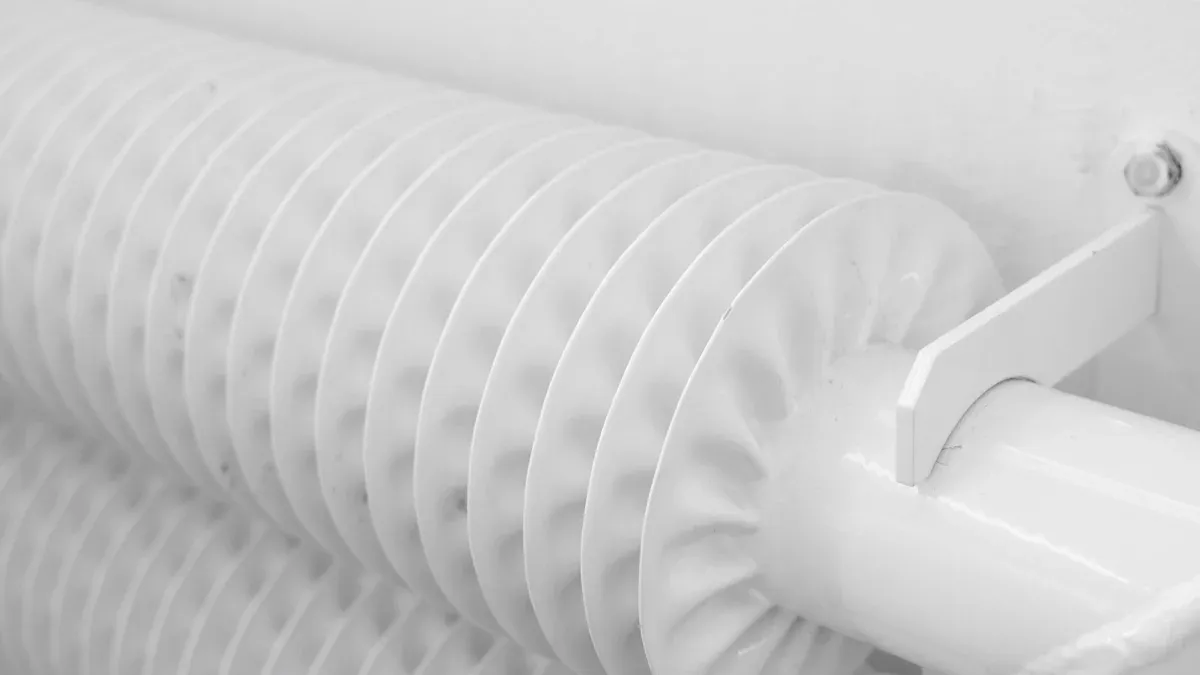
When you need to remove the heating element from your Whirlpool dryer, you must follow a systematic approach. Whirlpool dryers come in several models, but most share similar access points and removal steps. You can complete this repair with basic tools and careful attention to detail.
Accessing the Whirlpool Dryer Heating Element
Removing the rear panel or lifting the top/front panel
You must first access the interior of your Whirlpool dryer. The method depends on your specific model, but most Whirlpool dryers allow access through either the rear panel or the top/front panel.
- Unplug your dryer from the power source. Always start by disconnecting the dryer to prevent electrical shock.
- Pull the dryer away from the wall to create enough workspace.
- For many Whirlpool models, you can remove the lower front access panel. Insert a putty knife under the dryer door to release the clips on each side. Gently pry off the panel.
- Some models require you to remove the lint screen and the screws holding the top panel. Once you remove these screws, gently lift the top panel and hinge it backward.
- If your model requires rear access, remove the screws securing the back panel. Set the panel aside carefully.
Mẹo: Take photos of each step as you go. These images help you remember how to reassemble your Whirlpool dryer later.
Locating the heating element housing
Once you open the dryer, you need to locate the heating element housing. In most Whirlpool dryers, you will find the heating element on the right side or at the bottom rear of the appliance. The housing often looks like a metal canister or bracket. You may see wires connected to thermostats and the heating element itself.
- Look for a metal housing with several wires attached.
- Identify the mounting screws or clips that secure the housing in place.
- Make sure you have clear access to the heating element before proceeding.
Ghi chú: The heating element housing may feel warm if you recently used the dryer. Allow it to cool before you touch any components.
Steps to Remove the Faulty Heating Element
Disconnecting wires and removing mounting screws or clips
You must disconnect the heating element from the dryer before you can remove it. Follow these steps for a safe and efficient process:
- Mark or photograph the wiring connections. This step ensures you reconnect the wires correctly during reassembly.
- Carefully unplug all wires connected to the heating element, high limit thermostat, and thermal fuse. Use needle-nose pliers if needed, but avoid pulling on the wires themselves.
- Locate the screws or clips that secure the heating element housing. Most Whirlpool dryers use 1/4″ or 5/16″ screws.
- Remove the screws or release the clips holding the heating element in place. Set the hardware aside for reinstallation.
Cảnh báo an toàn: Always wear work gloves and safety goggles when working inside your Whirlpool dryer. Sharp edges and electrical components can cause injury.
Carefully pulling out the old heating element
After you disconnect the wires and remove the mounting hardware, you can remove the heating element from the dryer.
- Gently pull the heating element out of its housing. Avoid bending or damaging the metal canister.
- Inspect the element for visible signs of damage, such as broken coils or burn marks. If you see these issues, you have confirmed a faulty heating element.
- Set the old heating element aside for disposal or recycling.
You have now completed the process to remove the heating element from your Whirlpool dryer. This step prepares you for installing a new Whirlpool dryer heating element and restoring your appliance’s performance.
Pro Tip: Keep all screws, clips, and small parts in a container. This practice prevents loss and makes reassembly much easier.
How to Replace Heating Element in Whirlpool Dryer
Replacing the heating element in your Whirlpool dryer restores efficient drying and extends the life of your appliance. You should follow a systematic approach to ensure a safe and successful heating element replacement. This section guides you through installing the new part and reassembling your dryer for optimal performance.
Installing the New Whirlpool Dryer Heating Element
Transferring the high limit thermostat if needed
Before you install the new heating element, check if your old high limit thermostat needs to be transferred. Many Whirlpool models use a thermostat attached directly to the heating element assembly. If your replacement heating element does not include a new thermostat, you must move the existing one.
- Remove the screws securing the high limit thermostat to the old heating element.
- Gently lift the thermostat away from the old assembly.
- Align the thermostat with the mounting holes on the new heating element.
- Secure it using the original screws.
Mẹo: Handle the thermostat with care. Avoid bending the terminals or damaging the sensor.
Transferring the thermostat ensures your dryer maintains safe operating temperatures after you replace heating element components.
Positioning and securing the new heating element
Once you have prepared the new heating element, position it inside the dryer. Whirlpool recommends the following steps for proper installation:
- Slide the new heating element into the heating tube or housing, making sure it fits snugly.
- Align the mounting holes on the heating element with those on the dryer housing.
- Insert and tighten the screws or clips to secure the heating element in place.
You should avoid overtightening the screws. This prevents damage to the metal housing and ensures a stable fit. A properly mounted heating element reduces vibration and improves heat distribution.
Reconnecting wires and mounting hardware
After you secure the new heating element, reconnect all wires and hardware. Use the photos or labels you created during disassembly to match each wire to its correct terminal.
- Attach the wires to the heating element terminals, the high limit thermostat, and the thermal fuse if present.
- Confirm each connection is tight and fully seated.
- Double-check that no wires are pinched or touching metal surfaces.
Ghi chú: Proper wiring is critical for safe operation. Incorrect connections can cause the dryer to malfunction or create a fire hazard.
Completing these steps ensures your heating element replacement is both safe and effective. You have now finished the core part of the process to replace heating element parts in your Whirlpool dryer.
Reassembling the Dryer After Heating Element Replacement
Reattaching panels and double-checking connections
With the new heating element installed, you need to reassemble your dryer. Whirlpool recommends a careful approach to avoid missing any steps.
- Reattach the rear or front panel by aligning it with the mounting clips or screw holes.
- Secure the panel using the original screws. Tighten each screw evenly to prevent gaps.
- Lower the top panel if you lifted it earlier, and lock it into place.
- Reinstall the lint filter housing and insert the lint screen.
- Inspect all wiring connections one more time. Make sure each terminal is secure and matches its original position.
Safety Check: Before restoring power, perform a final visual inspection. Look for loose screws, stray wires, or misplaced parts.
Once you finish reassembly, move the dryer back into position. Reconnect the vent hose and plug the dryer into the power outlet. For gas models, turn the gas supply back on.
Now, run a test cycle with the dryer empty. Set it to a heated cycle and let it run for several minutes. Check for proper heat and listen for unusual noises. If the dryer heats up and operates smoothly, your heating element replacement is successful.
If you notice any issues, unplug the dryer and review your installation steps. Double-check all connections and mounting hardware.
You have now completed the process to replace heating element parts in your Whirlpool dryer. This careful approach ensures reliable performance and extends the life of your appliance.
Testing Your Dryer After Replacing the Heating Element
After you install a new heating element in your Whirlpool dryer, you need to verify that the repair succeeded. Proper testing ensures your dryer operates safely and efficiently. You also confirm that no other issues exist before you return the appliance to regular use.
Running a Test Cycle on Your Whirlpool Dryer
Powering on and checking for proper heat
You should follow a systematic approach when you power on your dryer for the first time after a repair. This process helps you catch any problems early and prevents further damage.
- Plug your dryer into the electrical outlet. For gas models, turn the gas supply back on.
- Start a timed dry cycle with the dryer empty. Listen for any unusual sounds and check for odd odors. These signs may indicate a problem with installation.
- Observe the dryer as it runs. You should feel the temperature inside the drum rise steadily. Place your hand near the vent to check for hot airflow. This step confirms the heating element works as intended.
- Run a small load of laundry to test the heating element under normal conditions. Monitor the drying time. Clothes should dry within a typical cycle.
- Watch for signs of overheating. If the dryer becomes excessively hot or shuts off unexpectedly, stop the cycle and inspect the thermostat and related components.
- Repeat the test cycle several times. Consistent performance across multiple cycles shows that your dryer is reliable and the repair is complete.
Mẹo: Always stay nearby during the first test cycle. Immediate attention to any issues can prevent further complications.
Troubleshooting If Your Dryer Still Doesn’t Heat
Even after you replace the heating element, your dryer may not heat properly. You need to use a structured troubleshooting process to identify the cause. This approach saves time and helps you avoid unnecessary repairs.
Inspecting thermal fuse, thermostat, and wiring
If your dryer fails to produce heat, begin troubleshooting by checking the thermal fuse. A blown fuse interrupts the circuit and prevents the dryer from heating. Use a multimeter to test for continuity. If the fuse is faulty, replace it.
Next, inspect the thermostat. A defective thermostat can cause the dryer to overheat or fail to heat at all. Test the thermostat with a multimeter and replace it if necessary.
Examine all wiring connections. Loose or damaged wires can disrupt power to the heating element. Secure any loose connections and replace damaged wires. You should also test the heating element again to confirm it functions correctly.
Ghi chú: Always unplug the dryer before performing any troubleshooting steps involving electrical components.
When to call a professional for dryer repair
Some dryer issues require advanced troubleshooting or specialized tools. If you have checked the thermal fuse, thermostat, and wiring but the dryer still does not heat, you may need professional help. Call a certified appliance technician if you encounter:
- Persistent heating problems after multiple repairs
- Electrical issues you cannot safely resolve
- Signs of gas leaks in gas dryers
- Unusual noises or burning smells during operation
A professional can diagnose complex problems and ensure your dryer operates safely. You protect your investment and avoid further damage by seeking expert assistance when needed.
Safety Reminder: Never ignore persistent dryer problems. Prompt troubleshooting and professional support help maintain safe and efficient operation.
Whirlpool Dryer Heating Element Replacement Cost, Lifespan, and Value
Typical Costs for Parts and Tools
Price range for heating elements and tools
When you plan to replace a heating element in your dryer, you should understand the typical costs for both parts and tools. Most Whirlpool dryer heating elements cost between $59 and $170, depending on the model and source. Some specialized parts, such as the WP8182528, can reach up to $191.30. You also need basic tools like a multi screwdriver and a putty knife. These tools usually cost between $28.92 and $63.40.
| Item Description | Price Range (USD) | Ghi chú |
|---|---|---|
| Whirlpool Dryer Heating Element (OEM 279838) | $59.00 | Heating element assembly with coil and insulators |
| Whirlpool Dryer Heating Element (various OEM parts) | $59.00 – $170+ | Prices vary by part number and source |
| Multi screwdriver (tool needed) | Approx. $28.92 | Tool required for installation |
| Putty knife (tool needed) | $28.92 – $63.40 | Useful for panel removal and vent cleaning |
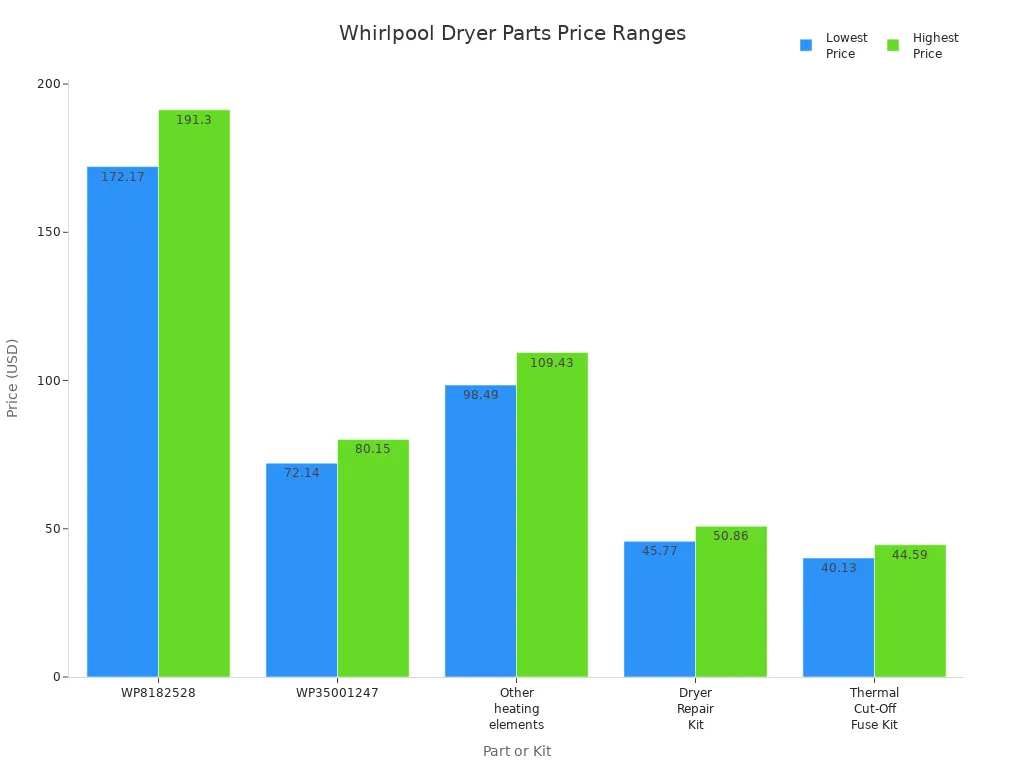
DIY vs. professional repair cost comparison
You can save money by replacing the heating element in your dryer yourself. The part usually costs $70 to $150. You will not pay for labor if you do the work. In contrast, a professional repair service charges $60 to $150 per hour for labor, with total costs ranging from $100 to $350. Most homeowners pay around $230 for a professional dryer repair. The table below compares the two options:
| Diện mạo | Tự thay thế | Professional Repair Service |
|---|---|---|
| Parts Cost | $70 to $150 (heating element only) | Included in total cost |
| Labor Cost | $0 (self-performed) | $60 to $150 per hour |
| Total Cost Range | $70 to $150 | $100 to $350 (average around $230) |
| Additional Notes | Requires diagnosis and technical skill | Labor fees and minimum charges may apply; ensures safety and effectiveness |
If you have basic tools and follow safety steps, you can complete a dryer heating element replacement at a lower cost than hiring a professional.
Whirlpool Dryer Heating Element Lifespan
Average years of use and factors affecting longevity
A typical Whirlpool dryer heating element lasts between 5 and 15 years. The actual lifespan depends on how you use and maintain your dryer. If you clean the lint filter after every load, you help prevent overheating. Annual cleaning of the exhaust vent also reduces the risk of lint buildup, which can cause the heating element to fail. You should avoid overloading your dryer and use the correct heat settings to reduce stress on the element. If the thermal fuse fails, the heating element may burn out repeatedly. Replacing the thermal fuse and maintaining related parts, such as vent ducting and rollers, will help extend the life of your dryer.
Regular maintenance and proper use are the best ways to maximize the lifespan of your dryer heating element.
Is It Worth Replacing the Heating Element in Your Dryer?
When to repair vs. replace your Whirlpool dryer
You should consider several factors before deciding to repair or replace your dryer. If your dryer is relatively new and in good condition, replacing the heating element is usually the best choice. The cost of repair, including parts and labor, often ranges from $100 to $200, which is much less than buying a new dryer. If your dryer has other worn-out components or is more than 10 years old, replacement may be more practical. You should also think about energy efficiency. Newer dryers use less energy and may save you money over time. Always check the thermostat, wiring, and ventilation before making your decision. If your dryer has a history of reliable performance and you maintain it well, a heating element replacement can restore full function for many more years.
You can often extend the life of your dryer with a simple heating element replacement, but if your appliance shows multiple signs of aging, investing in a new model may offer better value.
Maintenance Tips for Your Whirlpool Dryer Heating Element
Proper dryer heating element maintenance ensures your appliance operates efficiently and safely. You can prevent most heating element failures by following a few essential cleaning and care routines.
Cleaning and Care to Prevent Future Issues
Lint trap and vent maintenance
You should always keep the lint trap and vent system clean. Lint buildup restricts airflow, causing your dryer to overheat and increasing the risk of heating element failure. Follow these steps to maintain optimal performance:
- Clean the lint filter before and after every load. This simple habit prevents lint from entering the vent system and reduces fire hazards.
- Inspect and clean the dryer vent system at least once a year. Remove lint and debris from the entire vent, including the exhaust vent outside your home.
- Use only metal venting materials. Metal ducts resist damage and reduce lint accumulation compared to plastic or foil hoses.
- Keep the vent as short and straight as possible. Long or curved vents trap more lint and restrict airflow.
- Avoid pushing the dryer too close to the wall. This prevents kinking or crimping of the transition hose, which can block airflow.
Regular airflow is critical. Dryers require about 120 cubic feet per minute (CFM) of airflow, and vent systems are designed for approximately 150 CFM through a 4-inch duct.
The table below summarizes recommended cleaning intervals:
| Thành phần | Cleaning Frequency | Ghi chú |
|---|---|---|
| Lint Trap | After every load | Regular removal prevents buildup and maintains drying efficiency. |
| Lint Trap Slot | Approximately every 6 months | Deeper cleaning recommended, especially if drying performance decreases. |
| Dryer Vent | Every 1 to 3 years (general guideline) | Frequency depends on usage, vent length, and system specifics. |
| Dryer Vent | Annually (some manufacturers’ warranty requirement) | To maintain warranty coverage, annual cleaning may be required. |
| Dryer Vent | Every 6 to 9 months (heavy use or long vents) | More frequent cleaning needed for heavy usage or longer vent systems. |
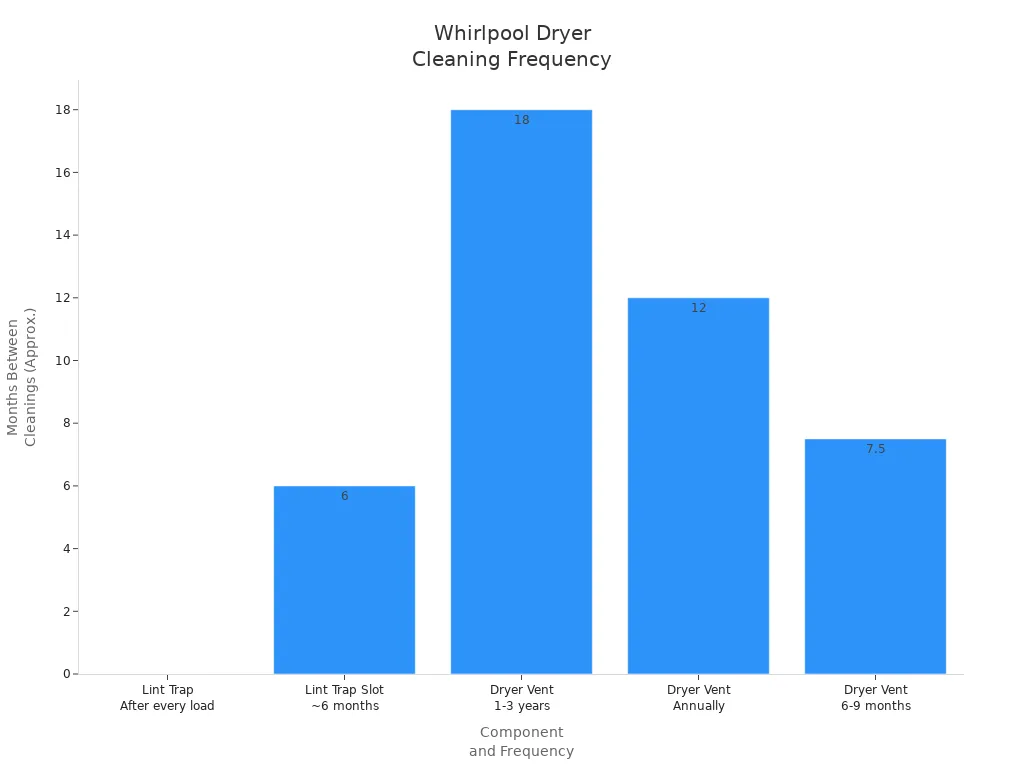
Whirlpool recommends cleaning the dryer air vent at least once every two years. If you have pets, long vents, or high laundry volume, increase the frequency.
Periodic interior cleaning
You should schedule periodic interior cleaning to remove lint that escapes the filter and settles inside the dryer. Annual professional maintenance helps vacuum excess lint, inspect venting, and check electrical components, including the heating element. This preventative care keeps your dryer running safely and reduces the risk of future failures.
Best Practices for Using Your Whirlpool Dryer
Avoiding overloads and monitoring drying times
You can extend the life of your dryer heating element by using your appliance correctly. Follow these best practices:
- Avoid overloading the dryer. Large loads force the heating element to work harder, increasing the risk of overheating.
- Monitor drying times. If clothes take longer to dry, check for airflow restrictions or lint buildup.
- Maintain proper airflow by cleaning vents and lint filters regularly.
- Never leave the dryer running unattended. This reduces the risk of fire and allows you to respond quickly to any issues.
- Schedule routine inspections to detect early signs of heating element wear or vent blockage.
- Use the correct heating element model for your Whirlpool dryer to ensure reliable performance.
- Ensure a stable voltage supply to protect the heating element’s coil and terminal connections.
Consistent dryer heating element maintenance and smart usage habits help you avoid costly repairs and keep your appliance running efficiently for years.
You can replace a Whirlpool dryer heating element with confidence by following each step and prioritizing safety. Regular dryer maintenance offers many benefits:
- Extends your dryer’s lifespan from 7–10 years to nearly 20 years
- Improves airflow, reduces drying time, and lowers energy bills
- Prevents costly emergency repairs and reduces fire risk
When you maintain your dryer, you save money and avoid unexpected breakdowns. Refer back to this guide whenever you need help with dryer repairs.
Câu hỏi thường gặp
How do you know if your Whirlpool dryer heating element is bad?
You notice your dryer does not heat, takes too long to dry, or shuts off mid-cycle. You can confirm by visually inspecting the element or testing it with a multimeter for continuity.
Can you replace a Whirlpool dryer heating element yourself?
Yes, you can replace it yourself with basic tools and safety precautions. Always unplug the dryer first. Follow step-by-step instructions for your specific model.
How long does it take to replace a Whirlpool dryer heating element?
Most replacements take 30 to 60 minutes. The process may take longer if you need to clean the interior or replace additional parts.
What tools do you need to replace a Whirlpool dryer heating element?
You need a Phillips screwdriver, flathead screwdriver, 1/4″ nut driver, multimeter, and work gloves. These tools help you safely access and replace the heating element.
Will a dryer run if the heating element is bad?
Your dryer will still run, but it will not produce heat. Clothes will remain damp after the cycle. You must replace the heating element to restore proper drying.
Should you replace the thermal fuse when replacing the heating element?
Many experts recommend replacing the thermal fuse if it shows signs of damage or fails a continuity test. This prevents future heating issues and protects your new element.
How much does it cost to replace a Whirlpool dryer heating element?
You typically spend $70 to $150 for the part if you do it yourself. Professional repair costs range from $100 to $350, including labor.
Can a clogged vent cause the heating element to fail?
Yes, a clogged vent restricts airflow and causes overheating. This can damage the heating element. Clean your vent regularly to prevent this problem.


